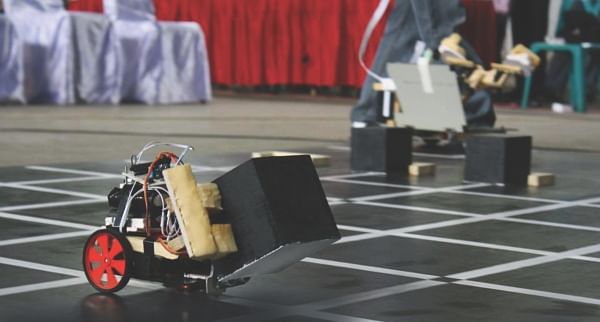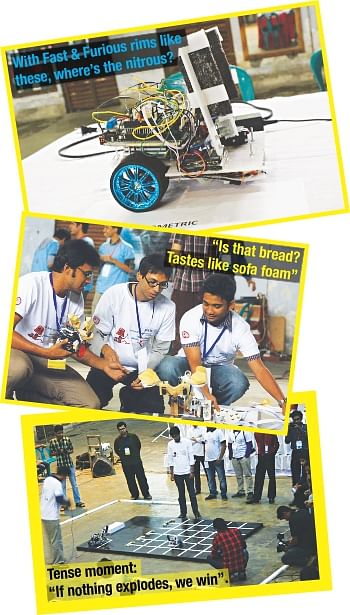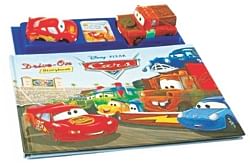
The Young
Bots of Bengal
By Jawad
 “A journey of a thousand miles begins with a single step.” - Lao Tzu
“A journey of a thousand miles begins with a single step.” - Lao Tzu
Robots are very cool things. Humanity may not yet have reached the stage where robots can become a serious threat to its existence as many like to predict, but we have gone far. There is a robot strutting around dodging the Martians and feeding us with coverage of our nearest planetary neighbour. And then there are the weird Japanese dolls that are so much like humans that you do triple takes. It makes you wonder where Bangladesh is in terms of robotic advancement.
Robotics in Bangladesh is still at its infancy. It started a few years ago with a few students building automated bots, but at the moment we are looking at quite a wave. The public and private universities alike, especially the engineering ones, are the front runners, as expected of the bright and talented minds there. We have had a couple of competitions this year: the Micromouse Contest at Rajshahi University of Engineering and Technology (RUET) back in March, and then the International Robotic Challenge (IRC Bangladesh 2012, Techfest) held on November at Bangladesh University of Engineering and Technology. Both of these contests were inter-university in nature and a healthy number of robots turned up and competed. Besides these, there have been some competitions inside the universities themselves, a notable example being Formula R arranged at BUET in June.
Just last week the largest IT programme in the country, the Digital World-2012 held at the Bangabandhu International Conference Centre, had a very well-applauded event in the Robo Experience Zone.
Robotics here is still competition-oriented. Rather than setting a distant goal like employing the robot in some very specific tasks, most of the robots are now built to solve some basic problems. It is indeed too much to ask for the advanced level of robotics displayed in the Robocon or the Robocup (the robot football tournament) at the current stage of robotics in Bangladesh. Most of the robots here are built to solve a maze, or follow a line. While that may sound simple to you, it actually takes quite a bit of effort.
For example, in the IEEE Formula R contest, the challenge for the robot was to navigate a curved black line on a white surface of length 55 feet. The robots were judged based on the originality in their hardware, accuracy of algorithm and lap timing.
The Problems
Robotics is not a recognised course of education in this country yet. The competitors learn, of course, but they have to do most of their learning by themselves. The student branches of IEEE (Institute of Electrical and Electronics Engineers) in RUET and BUET offer training workshops for the interested.
There are other problems too, mainly with the supplies. Tanvir Ahamed, Department of EEE, BUET and prize-winner at all the aforementioned competitions, says, “We don't have that sophisticated equipments at a low price here. There are some, mind, but very few. Even when we acquire those, we cannot tell for certain if they will actually work.”
Finding sponsors proves to be tough task as well. So is the availability of effective testing machines. But despite all the shortcomings, the rate at which robotics is growing in Bangladesh is quite astounding.
IRC -2012
This 5th November the Bangladesh leg of the International Robotic Challenge was held in BUET. The premise was that the top two teams would go on to grand finale to be held in Techfest 2013, India. The teams “BUET-Skull”, from BUET (duh!) and “Isometric” from Islamic University of Technology got the first two prizes respectively.
Digital World 2012
Quite possibly the most fascinating part of the event spanning 6th to 8th December was the Robo Experience Zone, but not just because the other events were mostly speeches. There were a good number of robots - and interesting ones too. IUT and MIST brought their entries to the Lunabotics, NASA. AIUB brought a Quad Copter and CUET brought a Robotic Hand along with three entries from BUET. So if you are thinking the robotics here is dominated entirely by the students of the public engineering varsities, you couldn't be more wrong.
Things to look forward to
IRC Techfest 2012-13 to be held on January 3rd to 5th next year at IIT, Bombay. The champion and runners-up from the event in Bangladesh will participate there.
There is also the Global Robotics Competition (GRC) of Techkriti '13, IIT Kanpur. The Engineering Students' Association of Bangladesh (ESAB) is going to organise the Bangladesh round on 6-7 February next year.
So are these all? Of course not. These are just the efforts from the undergraduate students at various universities. We have our pride and joy in the Chondrobot-2, made by some brilliant students in BRAC University, which was chosen the Best Asian Robot in the Annual Lunabotics Mining Competition arranged by NASA this May. And this reporter found seven more teams working on their own robots as we speak. The future is here.
 Robots in books
Robots in books
Book publishers are finding ever more creative ways to attract the current joystick wielding readers. One way is to use a ‘robot’ gadget described above. Pixars Cars spawned a plethora of merchandise for kids to cry over. This story book tells the tale of the racecar Lightning Mcqueen and his tow truck friend Tow Mater. The book comes with a toy car that has infrared lights that can follow or ‘read’ a certain track. Every few page, there’s a track with the road marked out in black paint and the cars are supposed to race over them. Slow progress, gimmicky and the car are very shoddily designed. But there you have it, robots to attract readers.
